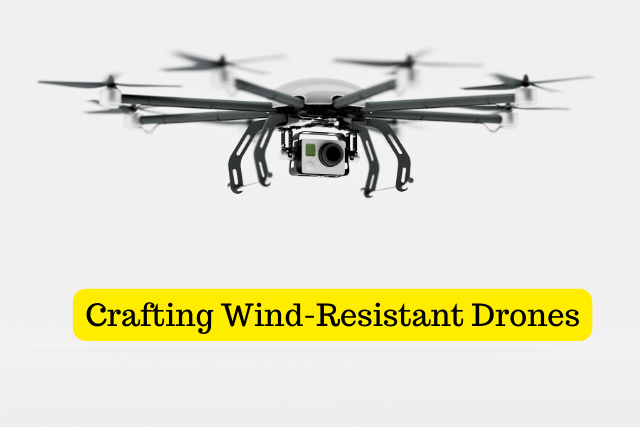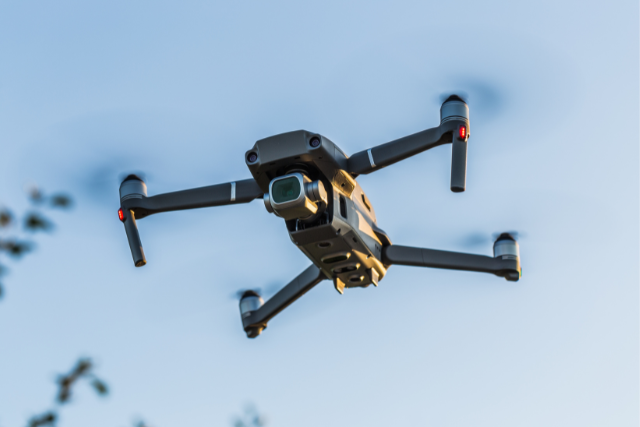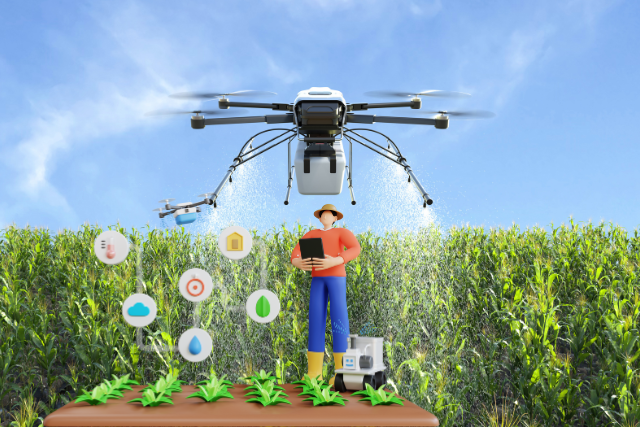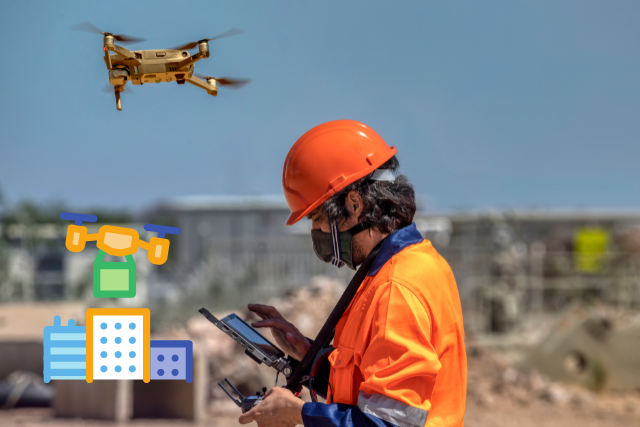Imagine your drone slicing through the gusty winds like a hot knife through butter, unswayed and steady. You’ve probably wondered how to achieve this level of wind resistance in your drone designs.
It starts with understanding the dance between aerodynamics and wind dynamics. You’re halfway there by choosing the right materials and shaping your drone to cut through the air.
But there’s more – from tweaking the weight distribution to optimizing the propeller design, each element plays a crucial role.
We’re about to uncover these design secrets, guiding you to compete with the wind and harness its power. Why settle for less when your drone could be the master of the skies?
Let’s get started.
Key Takeaways
- Aerodynamic designs and nature-inspired shapes significantly reduce air resistance, improving wind resistance.
- Advanced control systems with adaptive flight algorithms adjust in real time to maintain stability in windy conditions.
- Material selection, focusing on lightweight and tough materials like carbon fiber, enhances drone durability against strong winds.
- Testing strategies, including wind tunnel testing and field trials, are crucial for optimizing drones for better wind resistance.
Understanding Wind Dynamics
To truly grasp how drones stay stable in the air, it’s key to understand how wind behaves and affects their flight. Wind isn’t just a breeze you feel on a sunny day; it’s a powerful force that can instantly change direction and speed.
Imagine you’re flying a kite. You’ve got to constantly adjust the string to keep it in the air, right? Drones do something similar, but they use motors and sensors instead of a string.
Here’s the deal: when wind hits a drone, it doesn’t hit evenly. One side might get more wind than the other. This could make the drone tilt or even flip over if it wasn’t designed to handle it. But don’t worry; drone engineers have got this figured out.
They use technology and design to ensure drones can sense these changes and adjust quickly. This means your drone can stay stable even in strong winds, giving you that perfect shot or keeping an eye on things from above.
Aerodynamic Shapes Explained
Diving into the world of aerodynamics, you’ll find that the shape of a drone plays a crucial role in its ability to resist and maneuver through the wind. Imagine the wind as a river. Just like a sleek boat cuts through water more easily than a boxy one, drones with aerodynamic shapes glide through air currents with less resistance.
Now, think of a drone with rounded edges and a streamlined body. This isn’t just for looks. These shapes help reduce the drag of the air, trying to hold the drone back as it moves forward. The smoother and more streamlined the shape, the less the air can grab onto it, allowing the drone to slice through the wind more efficiently.
Here’s a fun fact: some drones are inspired by nature. Have you ever noticed how birds or fish are shaped to move seamlessly through their environments?
Designers often mimic these natural forms to minimize wind impact on drones. So, when you see a drone with a bird-like shape, it’s not just for show; it’s a carefully thought-out design to conquer the wind and soar with ease.
Material Selection for Durability
Choosing the right materials is key to building drones that withstand the toughest winds. You’re aiming for durability without sacrificing performance. So, what’s the secret? It’s all about finding the perfect blend of strength and lightness.
First off, let’s talk about carbon fiber. This material is a game-changer. It’s lightweight yet incredibly tough. Drones with carbon fiber frames can take a beating from strong winds and keep flying. They don’t weigh much, so you’re not sacrificing speed or agility.
Next up, aluminum. It’s another top pick for drone construction. Aluminum is not as light as carbon fiber but lightweight and offers fantastic durability. It’s also corrosion-resistant, so your drone can handle damp conditions without rusting.
But don’t forget about plastics. High-quality plastics, like ABS or polycarbonate, offer flexibility. They can absorb impacts without breaking, making them ideal for protecting your drone’s electronics in rough weather.
Advanced Control Systems
You’ve seen how the right materials can toughen up a drone against the wind, but now let’s talk about what makes it smart: advanced control systems.
These systems use adaptive flight algorithms, real-time response mechanisms, and gyro stabilization techniques to keep your drone steady and responsive, no matter how strong the gusts are. It’s like giving your drone a brain that’s always learning and adapting to the air around it.
Adaptive Flight Algorithms
Harnessing the power of advanced control systems, adaptive flight algorithms enable drones to adjust their flight paths in real-time, combating the unpredictable challenges of strong winds. Here’s how they break free from the constraints of harsh weather:
- Sensing Wind Speeds: They constantly measure wind conditions, making split-second decisions to keep them stable.
- Adjusting Angles: By tilting and rotating on the fly, they maintain their course without missing a beat.
- Speed Control: They speed up or slow down, ensuring they’re not blown off course.
- Energy Efficiency: They optimize power use, so you’re not constantly recharging.
This tech empowers your drone to dance with the wind, not fight against it. It’s about embracing freedom, even in the air.
Real-Time Response Mechanisms
Building on adaptive flight algorithms, advanced control systems offer an even more dynamic way to keep your drone steady against the gusts.
These systems respond in real time to changes, ensuring your drone doesn’t just survive but thrives in windy conditions.
Here’s a quick look at what makes these systems tick.
| Feature | How It Helps |
|---|---|
| Predictive Adjustments | Anticipates wind changes, adjusting flight path proactively. |
| Sensor Fusion | Combines data from multiple sensors for accurate wind gauging. |
| Adaptive Motor Control | Adjusts motor speed individually for balance. |
These components work in harmony, giving your drone the freedom to navigate the skies, no matter how unpredictable they become. You’re not just flying; you’re conquering the elements with science at your fingertips.
Gyro Stabilization Techniques
Diving deeper into advanced control systems, let’s explore how gyro stabilization techniques keep your drone steady in the face of strong winds.
- Gyroscopes measure rotation – They detect any unintended movement and instantly counteract it, keeping your drone level stable.
- Feedback loops are crucial – These systems constantly adjust in real-time, ensuring your drone responds accurately to even the slightest wind shifts.
- Sensitivity settings can be adjusted – You can tweak your drone is responsiveness to the gyro’s corrections, making it adaptable to different weather conditions.
- Integration with other systems – Gyro stabilization doesn’t work alone; it’s part of a team, coordinating with GPS and onboard sensors to maintain the course and altitude, no matter how gusty it gets.
Use these techniques to set your drone free, soaring confidently through turbulent skies.
Propeller Design and Efficiency
Why should you care about the design of a drone’s propellers? Well, it’s simple. The right propellers can make your drone a hero in the face of strong winds. You’ve got a drone because you crave freedom—the sky as your playground, right?
So, let’s ensure it’s equipped to soar, unhindered by gusts.
Propellers are your drone’s wings. They slice through the air, creating lift and movement. But not all propellers are created equal. Their design – shape, size, and material – greatly affects efficiency and wind resistance. Think about it. Larger propellers push more air, offering better control in windy conditions. But there’s a trade-off. They also demand more power.
Material matters, too. Flexible materials may absorb vibrations, making for smoother flights. But, they can warp under strong winds, losing efficiency. Stiffer materials stand firm, keeping your drone stable and responsive.
Weight Distribution Essentials
Let’s zoom in on how spreading out your drone’s weight can drastically uplift its performance against the whims of the wind. You must balance it just right to keep it steady and responsive.
Here’s a simple breakdown:
- Center of Gravity: Everything hinges on this. You want your drone’s center of gravity right in the middle. This balance point helps it stay stable in gusty conditions.
- Battery Placement: Since the battery is a heavyweight champ, placing it centrally can make a huge difference. It’s not just about powering up but balancing the act.
- Lightweight Components: Opt for lighter materials where you can. Every gram you shave off means a better fight against the wind. Think carbon fiber over metal.
- Even Distribution: Spread out the weight evenly across the drone’s frame. This ensures that your drone doesn’t tip over or drift too much when the wind hits.
Adaptive Flight Modes
Now, let’s talk about adaptive flight modes, which are key to stabilising your drone in strong winds. These modes use dynamic stability control and adjust the drone’s flight path in real-time. This way, your drone can react quickly to sudden gusts, ensuring a smoother and safer flight.
Dynamic Stability Control
To tackle the challenges of high winds, drones often employ dynamic stability control, adapting their flight modes in real time. Here’s how they do it:
- Gyroscopes and Accelerometers: These sensors detect even the slightest movements, helping the drone stay level and stable.
- Software Algorithms: They quickly adjust the drone’s speed and direction, ensuring it doesn’t drift away.
- Propulsion Control: Each motor can speed up or slow down independently, allowing for precise positioning against the wind.
- Tilt Mechanisms: By tilting into the wind, drones can counteract the force, maintaining their desired path.
This dynamic approach allows you to fly your drone without worrying about the wind ruining your day. It’s all about adapting and overcoming, ensuring your flight is smooth and your footage stunning.
Real-Time Adjustments
Diving deeper into how drones combat wind, adaptive flight modes make real-time adjustments to keep your flight smooth and controlled.
This smart tech is your drone’s secret weapon against unpredictable gusts. When wind hits, your drone doesn’t just endure; it adapts. It’s like having an expert pilot on board, tweaking and turning to match the challenge head-on.
These adjustments are automatic, freeing you to focus on capturing those breathtaking shots or exploring new heights without worry. Adaptive flight modes read the environment in milliseconds, adjusting propeller speed and drone tilt to counteract wind forces.
This ensures your drone stays on course, allowing you to explore the skies confidently. It’s technology at its finest, working quietly behind the scenes to liberate your flight experience.
Testing and Optimization Strategies
Ensuring your drone can withstand strong winds starts with rigorous testing and clever optimization strategies. You’ve got to put your design through the wringer to ensure it’s up to the challenge.
Here’s how you can do just that:
- Wind Tunnel Testing: Start by simulating various wind conditions in a wind tunnel. It’s like putting your drone in a hurricane simulator – you’ll quickly see how it handles high winds.
- Field Trials: Nothing beats real-world testing. Take your drone out on windy days and see how it performs. You’ll learn a lot by observing how it navigates the unpredictable gusts outdoors.
- Iterative Design: Based on your tests, tweak and adjust your drone’s design. Maybe you’ll find that adjusting the angle of the propellers or the weight distribution can make a big difference. It’s all about trial and error.
- Software Simulations: Use software to simulate wind conditions and your drone’s response. This can help you make adjustments before physical testing, saving you time and resources.
Conclusion
You’ve now dived into the secrets behind crafting wind-resistant drones. From shaping them just right, picking tough materials, to tweaking controls, every bit counts. Propellers and weight balance play huge roles too.
And guess what? Switching up flight modes lets your drone adapt on the fly.
But don’t forget, testing’s key to nail that perfect design. So, apply these tips and watch your drone soar, steady and strong, no matter the wind. Happy flying!




